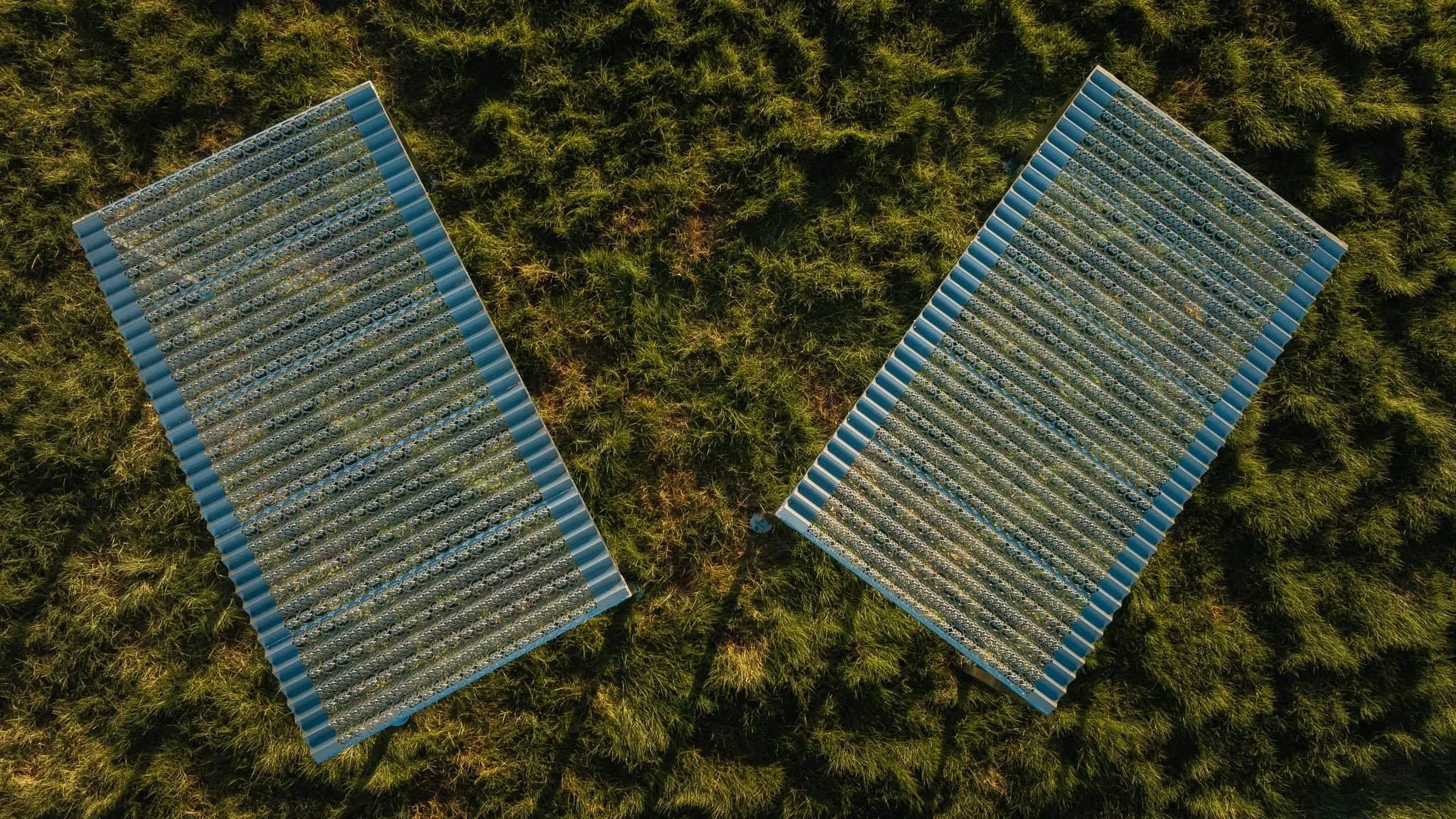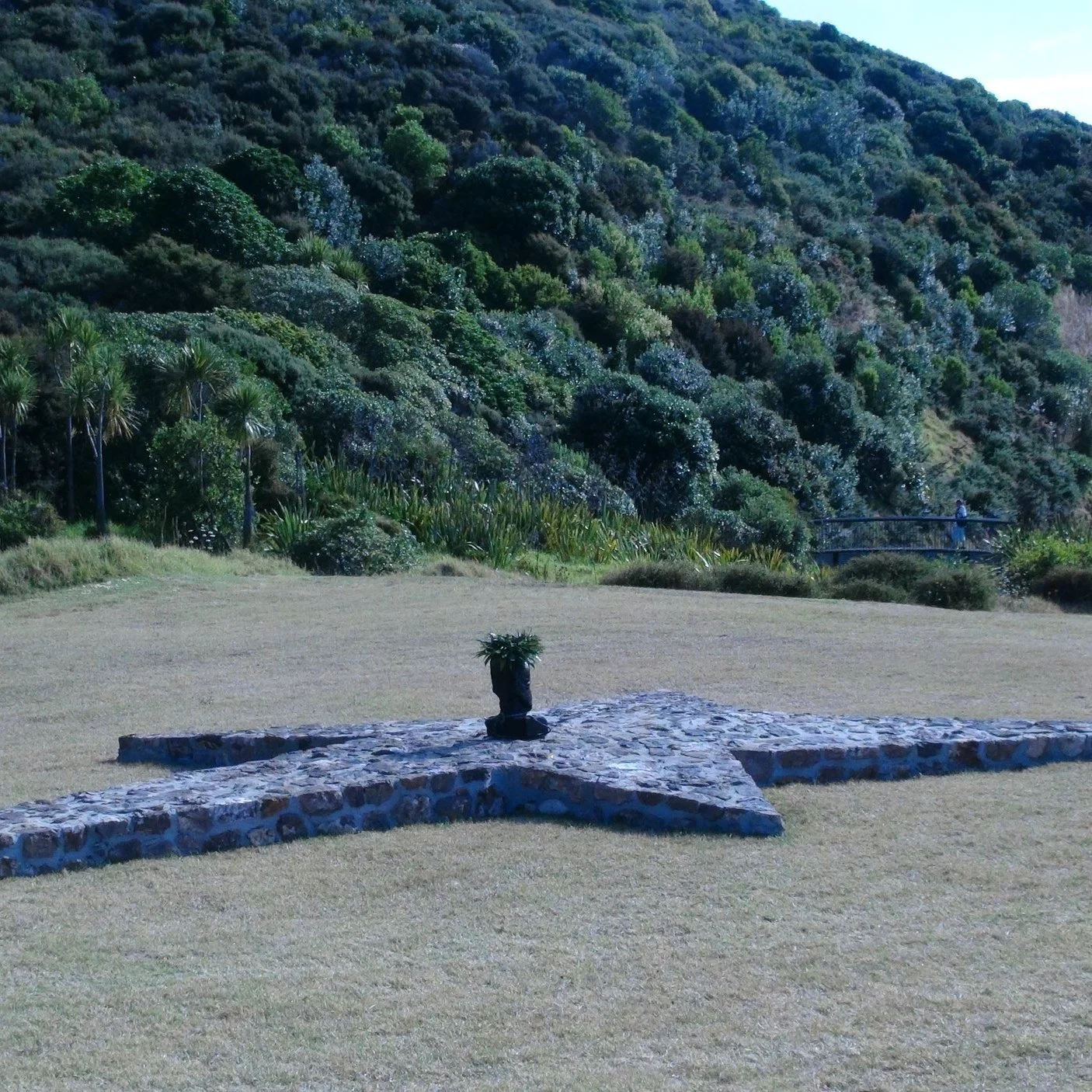Public Art
Moemoeā: A Model for Dreaming, Sculpture on the Gulf, waiheke island, TĀmaki MaKAURAU Auckland 2024
Moemoeā: A Model for Dreaming is a metal canopy, under which we can lie and daydream. Raised on poles, it provides shelter to visitors, a moment of pause. We can look up at the kowhaiwhai pattern and consider the ancestral stories it holds or down on the moving shadows it casts on the ground. Hutchinson’s canopy recalls the corrugated-iron roofs used in settler-style homes around Aotearoa New Zealand, while its pattern offers a counter rhythm.
Hana, Te Pae, Christchurch Convention Centre, Ōtautahi Christchurch, 2021
Hana means flame, glow and warmth. Here it references the Whare of the convention centre, and the ahi kā, keeping the home fire burning, keeping the building warm. The form of work is a translation of a floating tukutuku panel as a curtain made of beads and pounamu and suspended in a glow of light.
Hīkoi Ngahere, cordis Hotel, Tāmaki Makaurau Auckland, 2021
Hīkoi Ngahere is an extensive suite of works that provide a consistent narrative, which infuses the Cordis Hotel with works that express the unique natural beauty of Tāmaki Makaurau. Hīkoi Ngahere connects the viewer with the landscape, mythology and symbolism of Te Ao Māori and Aotearoa.
Photo: Russ Flatt
Aroha ki te Ora, Britomart Precinct Tāmaki Makaurau Auckland, 2020
The concept for Aroha ki te Ora references the Ngāi Tahu creation story. According to Ngāi Tahu tradition, Aoraki, New Zealand’s highest mountain, also known as Mount Cook, is the most sacred of tupuna (ancestors).
Hoa Kohine (Girlfriend), commissioned by Christchurch Art Gallery Te Puna o Waiwhetū, 2018
Commissioned in 2018 - the year of the 125th anniversary of women gaining the right to vote in Aotearoa New Zealand. Hoa Kōhine (Girlfriend), refers to women, and to the friendship between women. ‘Girlfriend’ is what women friends call each other, in an affectionate sort of way. When the first European settlers came to Christchurch some of the women brought lace curtains, to bring a piece of home with them. In terms of Māoridom, craft practices like tāniko and muka are very similar in that the designs are very fine.
Photo: Dennis Radermacher
Kahu Matarau and PIKIHUIA I TE AU, I TE PŌ, Justice and Emergency Services Precinct Commission, ŌTAUTAHI christchurch, 2017
Kahu Matarau draws on kākahu (traditional feather cloak), the plumage of the kākāpō, an endangered native, nocturnal, flightless parrot, and the braided awa (rivers) of Canterbury. Made of more than 1400 individual anodised aluminium panels, the 36-metre long eight metre high façade wraps around the Lichfield St carpark façade at street level. The choice of the kakapo feather gives the building some prestige from a Māori perspective. The law is very important for how society works and how Māori interact with each other. The west facing Pikihuia i te ao, i te pō references the precious and extinct huia. The stylised huia feather motif alludes to an alliance between Ngāi Tahu and the crown made in 1936. Produced as frit applied to the window bays on the Durham Street frontage, to filter light and heat from the courtrooms.
I Love you, Aroha atu, Aroha mai, Day and night commission, Ronwood Avenue, Manukau City, Tāmaki Makaurau Auckland, 2015
I Love you, Aroha atu, Aroha mai is two neon text works, installed on the stairwell exterior of a carpark building; I Love you faces Ronwood Ave and Aroha atu, Aroha mai faces Davies Ave and Hayman Park.
The rainbow neon refers to Uenuku - the god of rainbows in Māori mythology. Rainbows or aniwaniwa were seen as omens and signs of future events. In contemporary society the colours of a rainbow signify freedom, peace, love and harmony.
star mound, Sculpture on the Gulf, Waiheke Island, 2015
For Headland Sculpture on the Gulf 2015, Hutchinson designed a platform based on the structural and conceptual architecture of the star mounds found on the island of Savaii. In 2002 Hutchinson began to research star mounds and architectural monuments on the islands of Savaii and Upolo in Samoa. Samoan mythology and cultural expressions reference the ritual of pigeon-catching (a chieftain sport) on the mound and magical rituals to cure illnesses. For Star Mound Hutchinson focused on a function of star mounds as places for the healing arts and transformative rituals, seeing them as places to renew our individual and collective selves.
I Like Your Form, former site of the Crown Plaza Hotel, Ōtautahi Christchurch, 2014 (temporary) Commissioned by FESTA
The intervention of the kupenga (net) artwork I Like Your Form in the Arcades, draws from the form of traditional Māori fishing kupenga and hinaki (eel traps) that were used to catch inaka (whitebait) and tuna (eels) in the Ōtākaro Avon River. The Ōtākaro plays a unique role in the traditional economy and culture of Ngāi Tahu. It was highly regarded as mahinga kai by Māori living around what is now the Christchurch area. The term ‘mahinga kai’ refers to natural resources and the area in which they are found. The intervention of the kupenga tensioned between the two sets of arcades is a reclaiming of place that is of significance to Ngāi Tahu.
All that you breathe, Victoria University of Wellington, TE Whanganui-a-Tara Wellington, 2013
All that you breathe responds to the concept of the Reading Room as a vessel that contains precious objects of value above the ground. The concept of elevating objects of value is an idea common to many cultures including Māori and Pacific and allows reference to the pātaka (storehouse).
Te waharoa ki te Ao mārama, Hamilton Lake, kirikiriroa Hamilton, 2012
Te Waharoa ki te Ao Mārama is a response to the history of the lake and its significance to tangata whenua in the past, now, and in the future. The lake was once a prime resource of food and materials. With sustained conservation, care and nurturing this will continue. The kōwhaiwhai design is Hutchinson’s interpretation of the Māngo-pare (Hammerhead shark) which is often referred to as a symbol of strength and perseverance. Of never giving up.
honoa ki te hono tawhiti,Auckland Art Gallery Toi o Tāmaki, 2011
Commissioned as part of the Auckland Art Gallery Toi o Tāmaki development, the four parts of Honoa ki te hono tawhiti form part of the fabric of the gallery building, linking it to the outside world and acting as threshold markers inside. The thresholds on each of the Gallery's four levels signal entry into the exhibition spaces and invite contemplation of the artworks on display. Based on traditional kōwhaiwhai (rafter painting) and elements from nature, the patterns rise up through the building like branches, uniting the old with new.
Shangri La, Chews Lane Precinct, Te Whanganui-a-tara Wellington, 2009
Before the settlement of Wellington the area of land that Chews Lane occupies was originally the seabed and shoreline. The original bay was surrounded in native bush which was also known for its towering totara trees. The artwork Shangri La is a series of animations that observe and proposition the physical architecture of the lane by implanting a virtual reality conceptual landscape acknowledging the area’s cultural and natural history. Shangri La, the first virtual binocular experience installed outdoors in New Zealand, weaves landscapes and stories around Chews Lane. The animations show shoreline waves, plant and bird life that were present prior to land reclamation, and two taniwha associated with the harbour.
beat the feet, SCAPE Christchurch Biennial of Art in Public Space, christchurch Cathedral, ŌTautahi Christchurch, 2008 (temporary)
Beat the Feet is informed by and responds to two Ngāi Tahu pepeha (tribal sayings):
Kā Pākihi whakatekateka a Waitaha
The plains where Waitaha strutted proudly
- Rākaihautū and Rakihouia, Waitaha
Ko ahau te takata. Ko Kuratawhiti te mauka Kākāpō
Kuratawhiti is the mountain home of the Kākāpō. I am the man that lays claim to it.
-Moki, Ngāi Tahu
The work recalls the routes that Waitaha, Kati Mamoe and Ngāi Tahu used regularly across and up and down Te Waipounamu, along with mahinga kai (cultivation/food gathering place), with acknowledgment and respect for the mauri (life principle) and mana (prestige) of the takiwa (territory/region).












